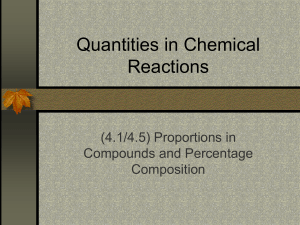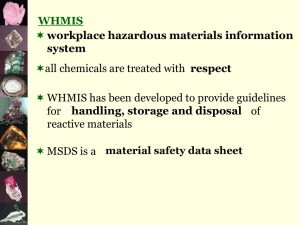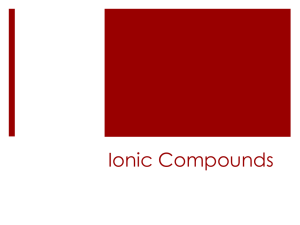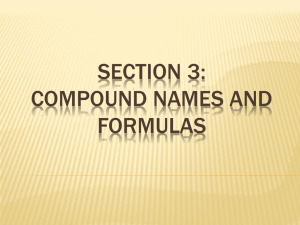3.4 Writing Chemical Formulas and Nomenclature
advertisement
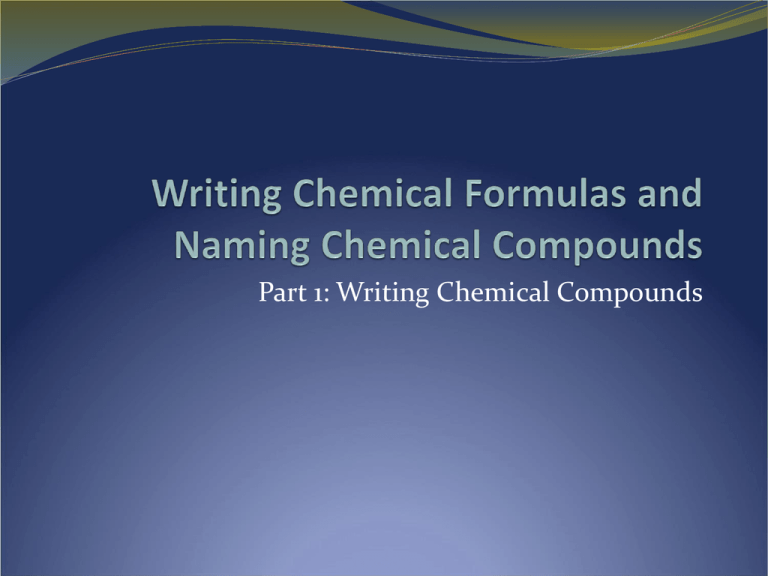
Part 1: Writing Chemical Compounds Chemical Formula short hand method of indicating a ratio of atoms in a compound. identifies the atoms in a compound the less electronegative element is listed first in the formula for covalent compounds, the formula tells you how many atoms of each type in the molecule. What does this look like? Valence or Oxidation Numbers describes how many electrons from an atom are used in bond formation if its an ionic bond indicates how many electrons are donated ( + ) indicates how many electrons are received ( - ) if it’s a covalent bond it indicates how many electrons are contributed to the bond as if the electrons were completely removed or gained. Oxidation Numbers An oxidation number is the charge an atom would have if the electron pair that is shared between two atoms belonged entirely to the more electronegative atom. Rules for Oxidation Numbers The following rules will help to assign oxidation numbers. The rules are listed in Priority Sequence. free atoms (0) Ex. Al(s) atoms bound to eachother. (0) Ex. Cl2, H2 ..... monoatomic ions have the same oxidation number as the charge number Ex. Cl1- (-1), Mg2+ (+2), ....... F is always (-1) O is almost always (-2) -except in peroxides H is almost always (+1) -except for metallic hydrides Assign oxidation numbers to the most electronegative atom first Rules Continued Group I (+1) Group II (+2) Al (+3) Group VII (-1) Group VI (-2) Group V (-3) When forming binary compounds with metals. nonmetals only In general, if two atoms form an ionic bond, the valence tells you the charges on the ions that are formed. If a covalent bond is formed, the valence tells you how many electrons the atoms contribute to the covalent bond. Writing Chemical Formulas Using Valences Use the Zero Sum Rule (for neutral compounds only) algebraic sum of oxidation numbers is zero for charged polyatomic ions, the sum of oxidation numbers equals the charge of the ion. Example: KF Each potassium ion has a charge of +1 and each fluorine ion has a charge of -1. Because there is one of each ion in the formula, the sum of the valences is zero. Polyatomic Ions ions made of more than two atoms are charged molecules very strong covalent bonds keep these ions together and react as a single inseparable ion. Need to Memorize... Ammonium NH4+ Chlorate ClO3- Acetate C2H3O2- Sulfate Hydroxide OH- Phosphate Nitrate NO3- Cyanide Carbonate CO32- SO42PO43CN- Writing Chemical Formulas Writing Chemical Formulas Writing Chemical Formulas Part 2: Naming Chemical Compounds Chemical Nomenclature Each chemical compound has been given a name. Some have a trivial or common name, H2O is known as water. These names have been used for centuries. However all chemicals have been given a name using Systematic Nomenclature. uniquely describes it s compound the name is derived from its chemical formula from a name a formula can be determined ex. NaCl common name: salt; (sodium chloride) H2O common name: water (hydrogen oxide) Positive Monoatomic Ions the name of the positive monoatomic ion is the same as the element name Ex. Li+ -lithium Stock System: if the metal has more than one oxidation number, a Roman Numeral is used: Sn2+ -Tin(II) Sn4+ Tin(IV) Old Method: the old name along with the suffix -ous or -ic is used to indicate the oxidation number. Sn2+ -stannous Sn4+ -stannic Memory Aid: -ous -indicates the lower oxidation number -ic -indicates the higher oxidation number Negative Monoatomic Ions add -ide to the end of the element name. Ex. chlorine (Cl) becomes chloride (Cl- ) Binary Compounds Containing a Metal and a Nonmetal consist of only 2 different elements the element with the more positive oxidation number is written first. Ex. NaCl and not ClNa Binary Compounds Containing Hydrogen and Another Element compounds of hydrogen and nonmetals from group VI and VII are called: hydrogen _______ide ex. HBr is call hydrogen bromide compounds of hydrogen and a metal, the metal is written first and are called: ________________ hydride ex. NaH is called sodium hydride Binary Compounds Containing 2 Nonmetals this method uses prefixes to indicate the number of nonmetal elements present __________name _______name ex. As2S3 is called diarsenic trisulfide NO is called nitrogen monoxide N2O5 is called dinitrogen pentoxide Naming Chemical Compounds Containing More than Two Elements Polyatomic ion + nonmetal ion name the positive portion first then the negative ion negative monoatonic ions end in –ide ex. NH4Cl is called ammonium chloride Cation + polyatomic ion oxygen containing polyatomic ions end in either –ate or –ite. an –ite polyatomic ion contains one less oxygen than does an-ate polyatomic ion. (Memory aide: memorize the –ate form of ions) ex. SO42- is sulfate and . SO32- is sulfite Group VII Polyatomic Ions have Additional Forms ClO ClO2 ClO3- ClO4- hypochlorite chlorite chlorate perchlorate Nomenclature of Acids Acid molecules contain hydrogen atoms that are easily removed when dissolved in water. These ionizable hydrogen atoms appear at the beginning of the chemical formula. Binary Acids hydrogen and a nonmetal element from group VI or VII is called: hydrogen ______ide. when this compound is dissolved in water, it becomes an acid called: hydro________ic acid ex. HCl (g) + H2O (l) → hydrogen chloride HCl (aq) hydrochloric acid Oxyacids hydrogen and a negative polyatomic ion is called: hydrogen polyatomic ion ex. H2SO4 (g) hydrogen sulfate H2SO3 (g) hydrogen sulfite when these compounds are dissolved in water are called: ex. H2SO4 (aq) sulfuric acid H2SO3 (aq) sulfurous acid Note: In acid form –ate polyatomic ions become -ic acid -ite polyatomic ions become -ous acid Proof for existence of intermolecular forces Gases have large distances between their particles, so short range forces between molecules are insignificant. ON COOLING AND COMPRESSING These weak forces become significant as the distances are reduced and their magnitude can now make a difference. So gases liquefy. So (GL) i.e. Liquefy ON further COOLING AND COMPRESSING The distances are further reduced. Forces become more significant and hence the liquid solidifies. So (LS ) i.e. solidifies Types of Intermolecular forces Van der waals’ forces • Arise due to random movement of electrons leading to the formation of instantaneous dipole and hence induced dipoles in molecules • Their strength depends upon the molar mass of the molecule. • These forces are effective over a short range. • They are dependent on the surface area of the molecule Dipole-dipole forces • These occur due to electrostatic attraction between molecules with permanent dipoles. • They are significantly stronger than van der waals’ forces in molecules of a similar size. • Molecule will have not just VVF but in addition to them the DPDP forces also. Hydrogen bonding • This occurs in molecules that contain H bonded to N/O/F • The non bonding epair on these N/O/F atoms interacts with the H atom that carries a high δ+ character coz its bonded to another of these small very electroatoms. • It’s the strongest of all the intermolecular forces. Examples to explain Van der waals’ forces Boiling points of noble gases Boiling points of Alkanes Boiling points of Halogens • He – 4K • Xe – 165 K • More atomic mass hence more no. of electrons • Methane111 K • Hexane 341 K • As molar mass increases the VVF also increase • As molar mass of halogens increases from F2 to I2 the boiling points also increase Boiling points of straight chain & branched Alkanes of same molar mass • n pentane BP 309 K • neo pentane BP 283 K Plastics and polymers They have very high Molar mass and very high surface area Examples to explain dipole-dipole forces Hδ+— Clδ- ||||||||||||Hδ+— Clδelectrostatic attraction • The HCl molecule is polar and has slight negative and slight positive centres on it. • This is a permanent DIPOLE and it interacts with other dipoles also and this electrostatic attraction will be DP-DP forces. Comparing the boiling points of non polar noble gases and polar hydrogen halides of same molar masses • Boiling points of Non-polar Ar, Kr and Xe will be lower than those of Polar hydrogen halides like HCl, HBr and HI • Because these are permanent dipoles they will have DP-DP forces along with VV forces Hydrogen bonding Hδ+— Fδ- ---------------Hδ+— Fδ hydrogen bond Considerably stronger than other intermolecular forces. Affects the physical properties of the compounds in which it exists. Examples of H-Bonding Comparing BP of Hydrogen peroxide, Fluorine and Hydrogen Chloride (Mr ~ 34-36) • Hydrogen peroxide • Hydrogen Chloride • Fluorine 431 K 188 K 85 K (polar, hydrogen bonded) (polar) (non polar) Comparing BP of Propane, Ethanal and Ethanol (Mr~ 44-46) • Propane C3H8 only VVF BP is 231 K • Ethanal CH3CO-H VVF, polar BP is 294 K • Ethanol CH3CH2OH VVF, polar, Intermolecular H bonding—352 K Collision Theory A reaction will only be successful if it has the correct orientation and energy. Baseball Model: Baseball bat is Reactant A, baseball is Reactant B. The reaction is successful if the batter hits a homerun! The scenarios… 1) Pitcher throws a fast ball, batter swings and misses. 2) Pitcher throws off-speed and the batter just makes contact with the ball. It’s a foul. 3) Pitcher throws a curve ball, batter swings and just hits the ball sending it to right field. 4) Pitcher throws a fast ball, batter swings and the ball goes flying high in the air. HOMERUN! When did the reaction occur? Try with molecules Reaction: H2 + I2 2 HI + H2 I2 HI How would you orient the molecules to get an effective collision capable of producing two hydrogen iodide molecules? Types of Reactions There are five types of chemical reactions we will talk about: • 1. 2. 3. 4. 5. • Synthesis reactions Decomposition reactions Single displacement reactions Double Displacement reactions Combustion reactions You need to be able to identify the type of reaction and predict the product(s) Steps to Writing Reactions Some steps for doing reactions • 1. 2. 3. Identify the type of reaction Predict the product(s) using the type of reaction as a model Balance it Don’t forget about the diatomic elements! (BrINClHOF) For example, Oxygen is O2 as an element. In a compound, it can’t be a diatomic element because it’s not an element anymore, it’s a compound! 1. Synthesis reactions • Synthesis reactions occur when two substances (generally elements) combine and form a compound. (Sometimes these are called combination or addition reactions.) reactant + reactant 1 product • Basically: A + B AB • Example: 2H2 + O2 2H2O • Example: C + O2 CO2 Practice • Predict the products. Write and balance the following synthesis reaction equations. • Sodium metal reacts with chlorine gas 2 Na(s) + Cl2(g) 2 NaCl (s) • Solid Magnesium reacts with fluorine gas Mg(s) + F2(g) MgF2 (s) • Aluminum metal reacts with fluorine gas 2 Al(s) + 3 F2(g) 2 AlF3 (s) 2. Decomposition Reactions • Decomposition reactions occur when a compound • • • • breaks up into the elements or in a few to simpler compounds 1 Reactant Product + Product In general: AB A + B Example: 2 H2O 2H2 + O2 Example: 2 HgO 2Hg + O2 Decomposition Exceptions • Carbonates and chlorates are special case decomposition reactions that do not go to the elements. • Carbonates (CO32-) decompose to carbon dioxide and a metal oxide • Example: CaCO3 CO2 + CaO • Chlorates (ClO3-) decompose to oxygen gas and a metal chloride • Example: 2 Al(ClO3)3 2 AlCl3 + 9 O2 • There are other special cases, but we will not explore those in Chemistry 11 Practice • Predict the products. Then, write and balance the following decomposition reaction equations: • Solid Lead (IV) oxide decomposes PbO2(s) Pb (s) + O2 (g) • Aluminum nitride decomposes 2 AlN(s) 2 Al (s) + N2(g) Practice Identify the type of reaction for each of the following synthesis or decomposition reactions, and write the balanced equation: Nitrogen monoxide N2(g) + O2(g) BaCO3(s) Co(s)+ S(s) (make Co be +3) NH3(g) + H2CO3(aq) NI3(s) 3. Single Displacement Reactions • Single Displacement Reactions occur when one element replaces another in a compound. • A metal can replace a metal (+) OR a nonmetal can replace a nonmetal (-). • element + compound product + product A + BC AC + B (if A is a metal) OR A + BC BA + C (if A is a nonmetal) (remember the cation always goes first!) When H2O splits into ions, it splits into H+ and OH- (not H+ and O-2 !!) Single Replacement Reactions • Write and balance the following single replacement reaction equation: • Zinc metal reacts with aqueous hydrochloric acid Zn(s) + HCl(aq) ZnCl2 + H2(g) Note: Zinc replaces the2hydrogen ion in the reaction Single Replacement Reactions • Sodium chloride solid reacts with fluorine gas NaCl(s) + F2(g) NaF(s) + Cl2(g) Note that fluorine replaces chlorine in the compound • Aluminum metal reacts with aqueous copper (II) nitrate Al(s)+ Cu(NO3)2(aq) 4. Double Replacement Reactions • Double Replacement Reactions occur when a metal replaces a metal in a compound and a nonmetal replaces a nonmetal in a compound • Compound + compound product + product • AB + CD AD + CB Double Replacement Reactions • Think about it like “foil”ing in algebra, first and last ions go together + inside ions go together • Example: AgNO3(aq) + NaCl(s) AgCl(s) + NaNO3(aq) • Another example: K2SO4(aq) + Ba(NO3)2(aq) KNO3(aq) + BaSO4(s) • Practice Predict the products. Balance the equation HCl(aq) + AgNO3(aq) 2. CaCl2(aq) + Na3PO4(aq) 3. Pb(NO3)2(aq) + BaCl2(aq) 4. FeCl3(aq) + NaOH(aq) 5. H2SO4(aq) + NaOH(aq) 6. KOH(aq) + CuSO4(aq) 1. 5. Combustion Reactions • Combustion reactions occur when a hydrocarbon reacts with oxygen gas. • This is also called burning!!! In order to burn something you need the 3 things in the “fire triangle”: 1) A Fuel (hydrocarbon) 2) Oxygen to burn it with 3) Something to ignite the reaction (spark) Combustion Reactions • In general: CxHy + O2 CO2 + H2O • Products in combustion are ALWAYS carbon dioxide and water. (although incomplete burning does cause some byproducts like carbon monoxide) • Combustion is used to heat homes and run automobiles (octane, as in gasoline, is C8H18) Combustion Reactions Edgar Allen Poe’s drooping eyes and mouth are potential signs of CO poisoning. Combustion • Example • C5H12 + 8 O2 5 CO2 +6 H2O • Write the products and balance the following combustion reaction: • C10H22 + O2 Mixed Practice • 1. 2. 3. 4. 5. State the type, predict the products, and balance the following reactions: BaCl2 + H2SO4 C6H12 + O2 Zn + CuSO4 Cs + Br2 FeCO3 Total Ionic Equations Once you write the molecular equation (synthesis, decomposition, etc.), you should check for reactants and products that are soluble or insoluble. We usually assume the reaction is in water We can use a solubility table to tell us what compounds dissolve in water. If the compound is soluble (does dissolve in water), then splits the compound into its component ions If the compound is insoluble (does NOT dissolve in water), then it remains as a compound Solubility Table Solubilities Not on the Table! Gases only slightly dissolve in water Strong acids and bases dissolve in water Hydrochloric, Hydrobromic, Hydroiodic, Nitric, Sulfuric, Perchloric Acids Group I hydroxides (should be on your chart anyway) Water slightly dissolves in water! (H+ and OH-) For the homework… SrSO4 is insoluble; BeI2 and the products are soluble There are other tables and rules that cover more compounds than your table! Total Ionic Equations Molecular Equation: K2CrO4 + Pb(NO3)2 Soluble Soluble PbCrO4 + 2 KNO3 Insoluble Total Ionic Equation: 2 K+ + CrO4 -2 + Pb+2 + 2 NO3- PbCrO4 (s) + 2 K+ + 2 NO3- Soluble Net Ionic Equations These are the same as total ionic equations, but you should cancel out ions that appear on BOTH sides of the equation Total Ionic Equation: 2 K+ + CrO4 -2 + Pb+2 + 2 NO3- PbCrO4 (s) + 2 K+ + 2 NO3Net Ionic Equation: CrO4 -2 + Pb+2 PbCrO4 (s) Net Ionic Equations Try this one! Write the molecular, total ionic, and net ionic equations for this reaction: Silver nitrate reacts with Lead (II) Chloride in hot water. Molecular: Total Ionic: Net Ionic:

